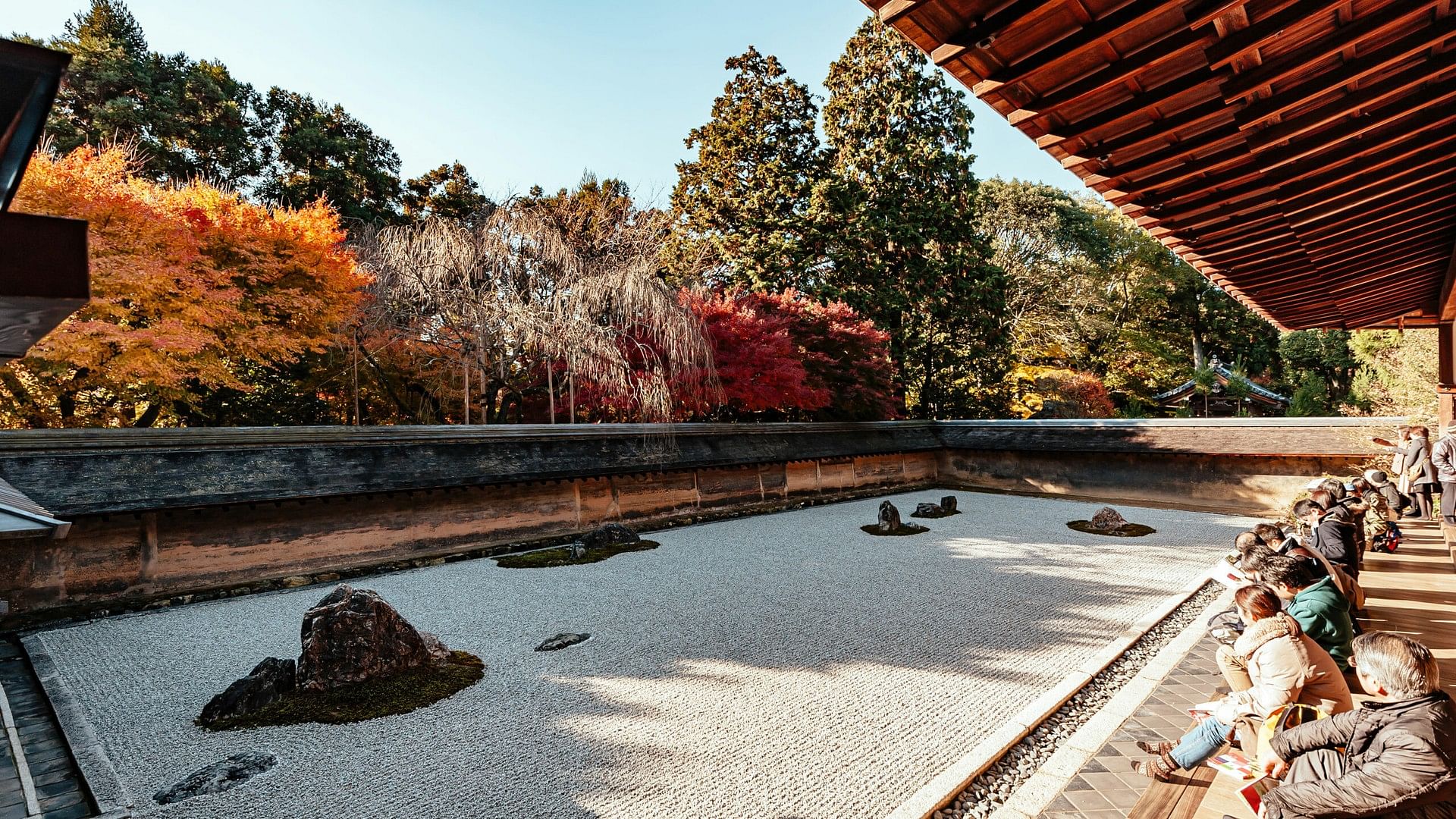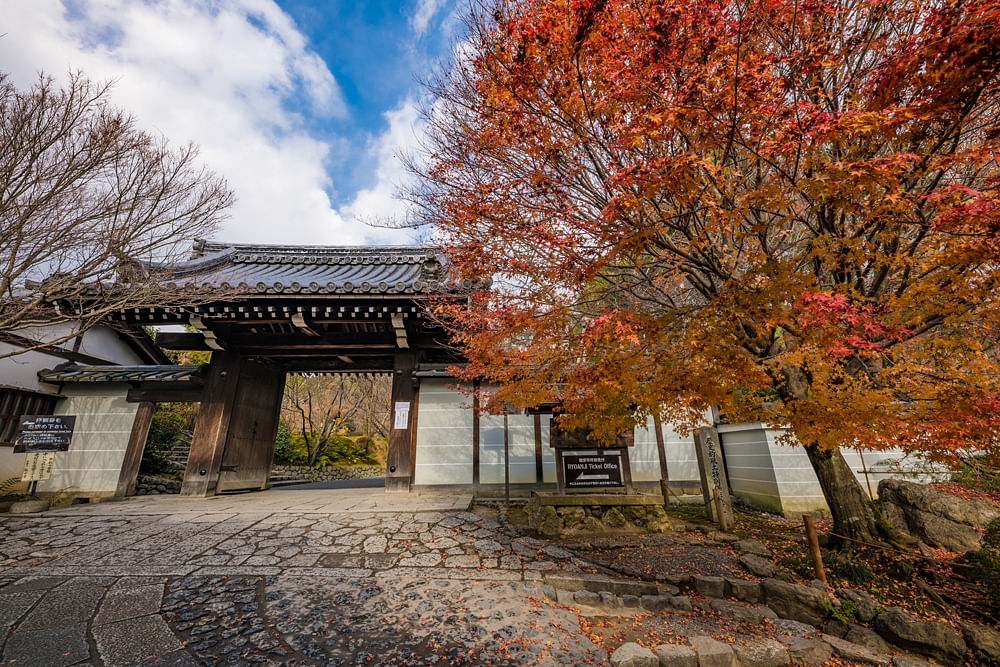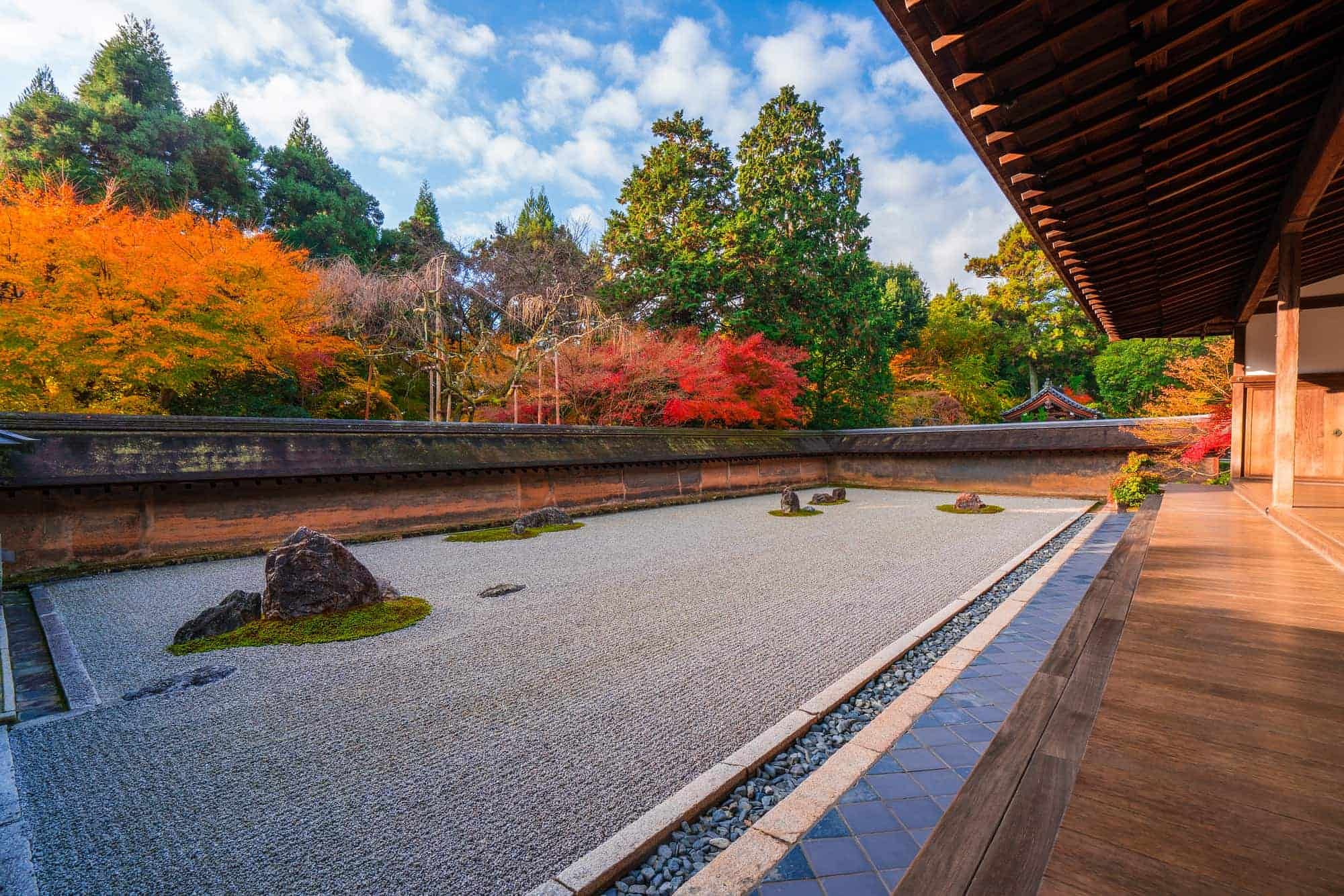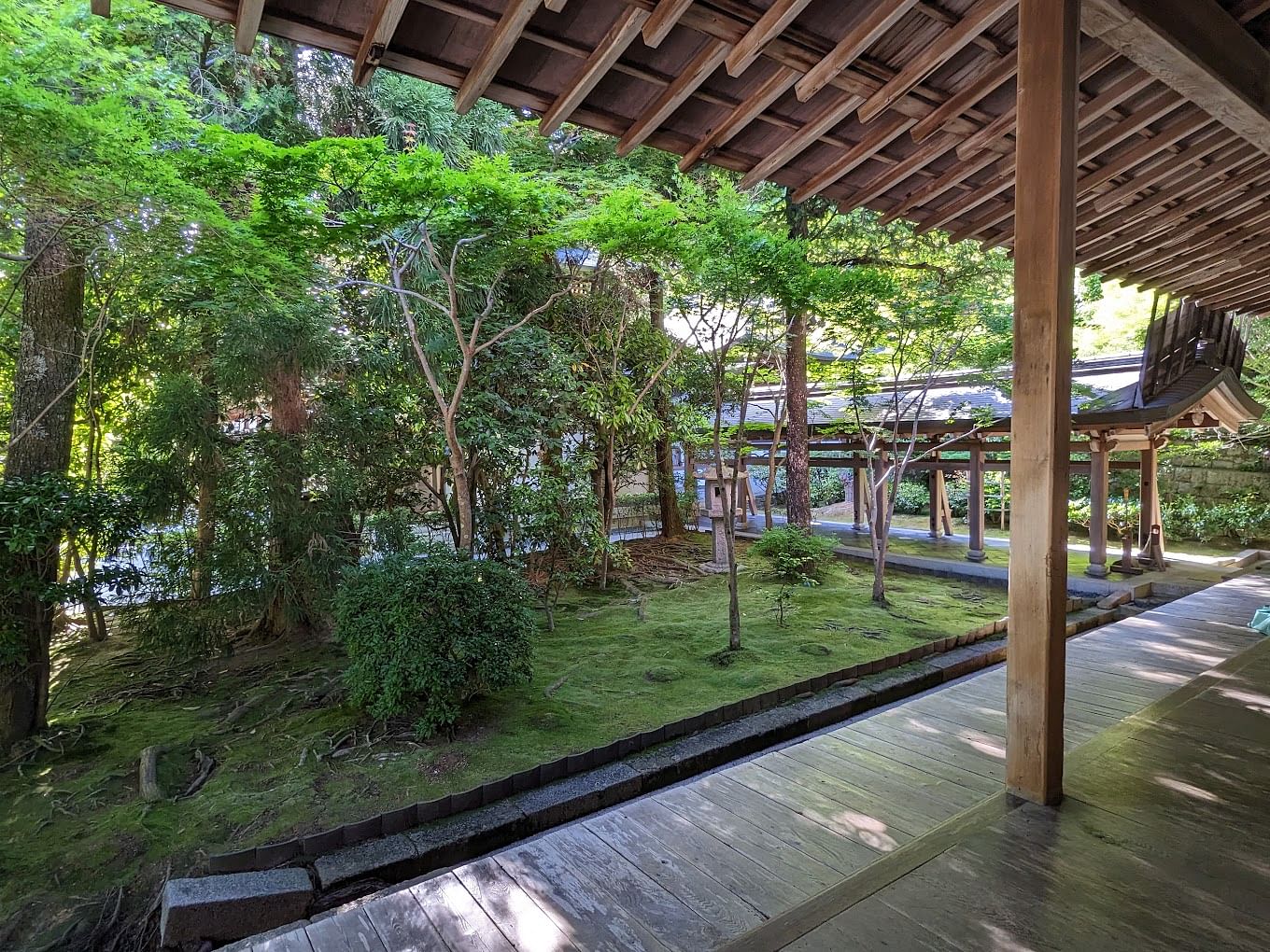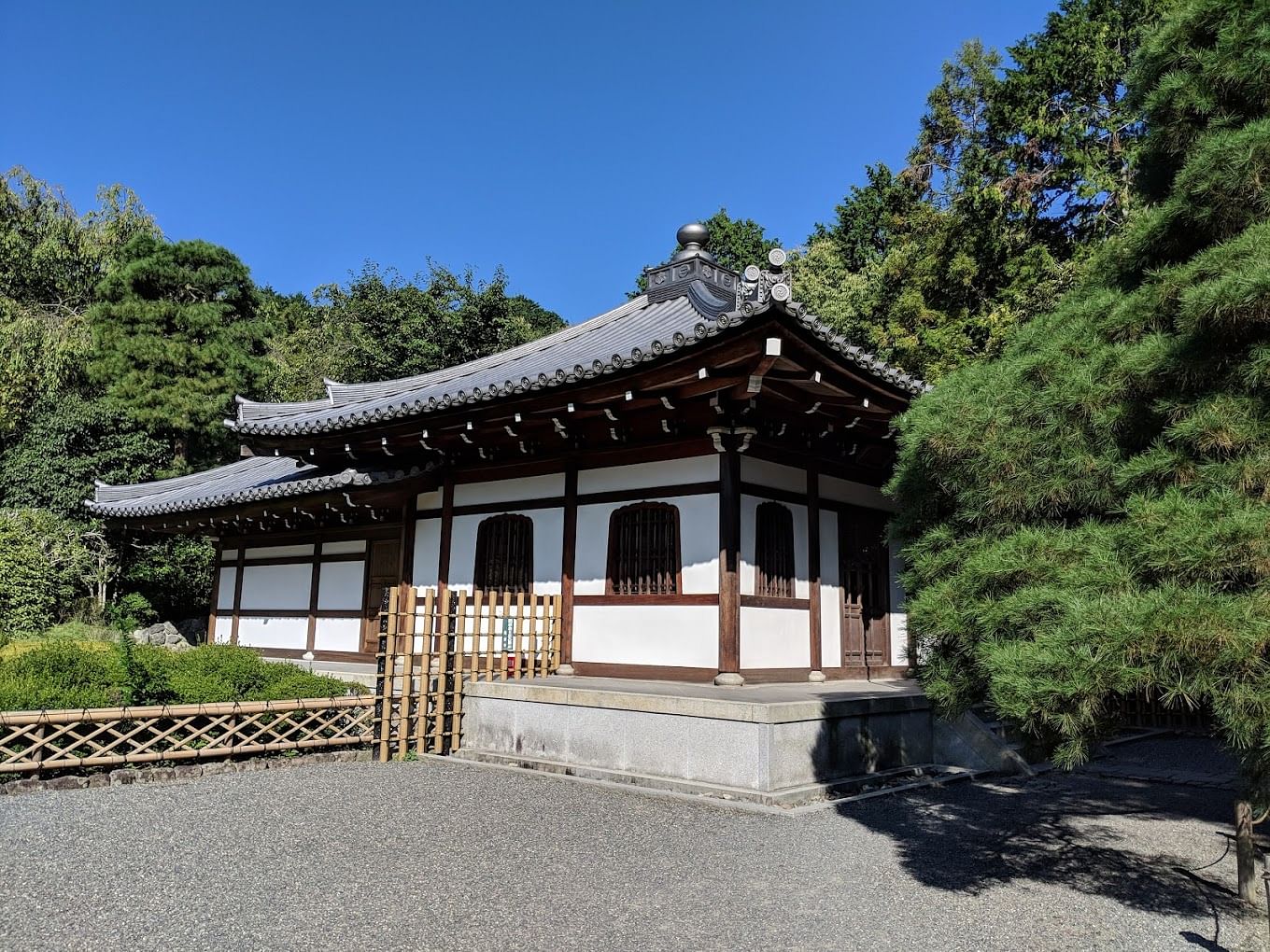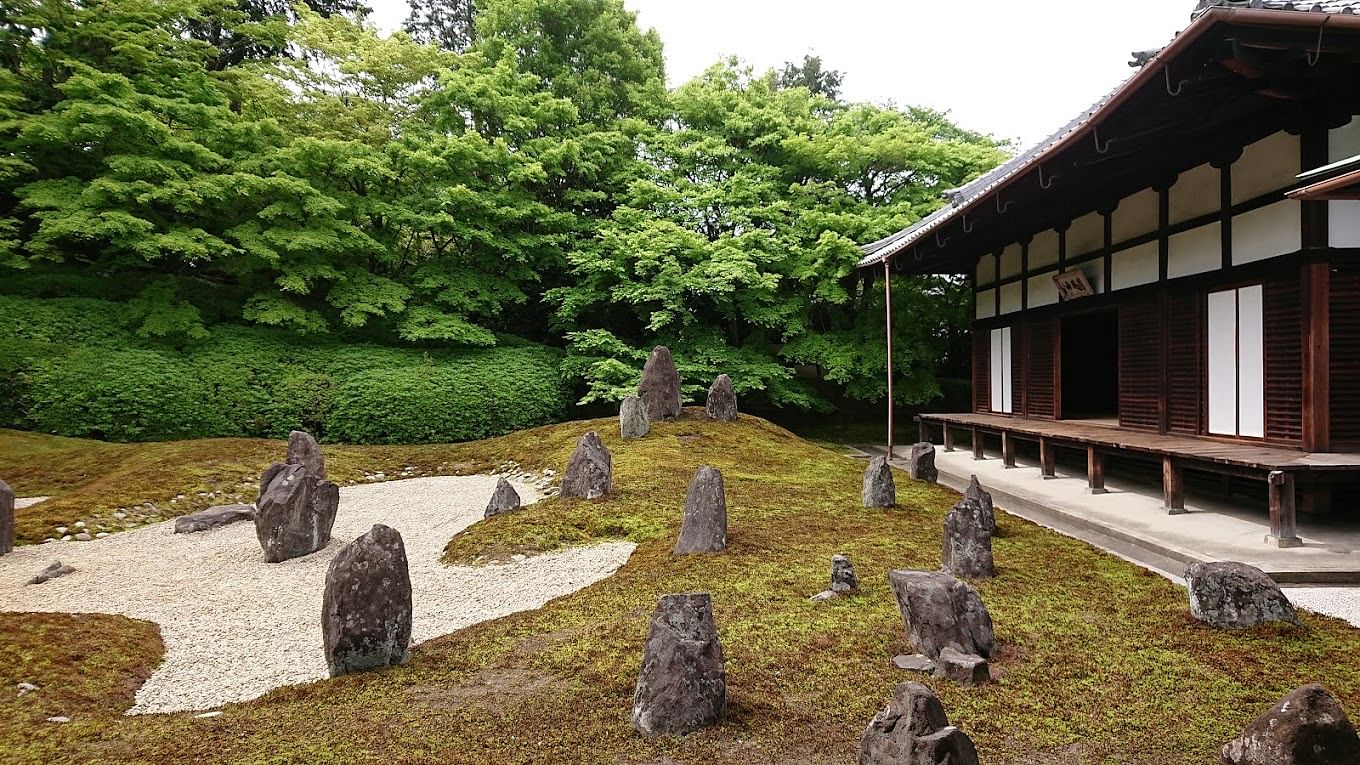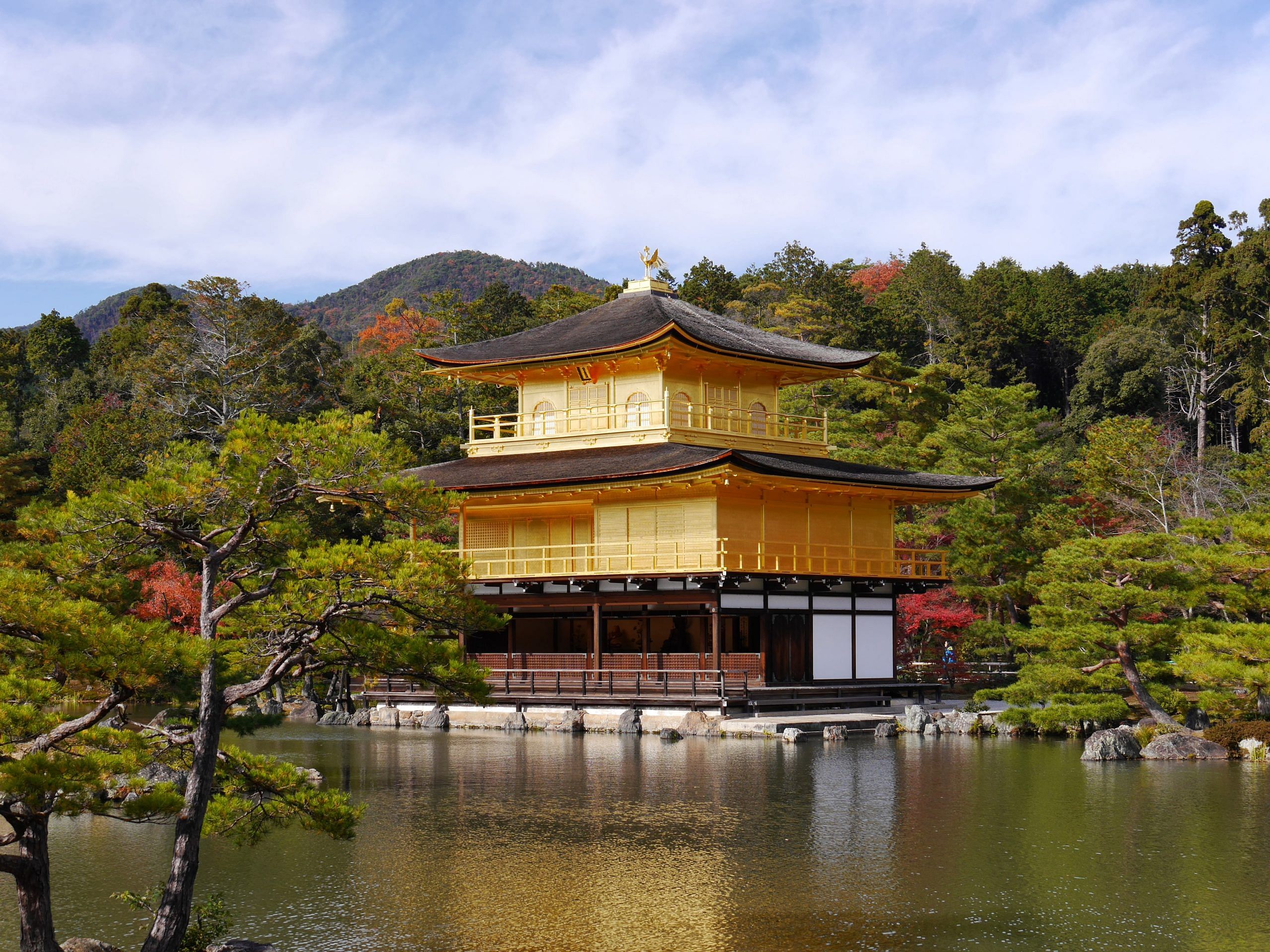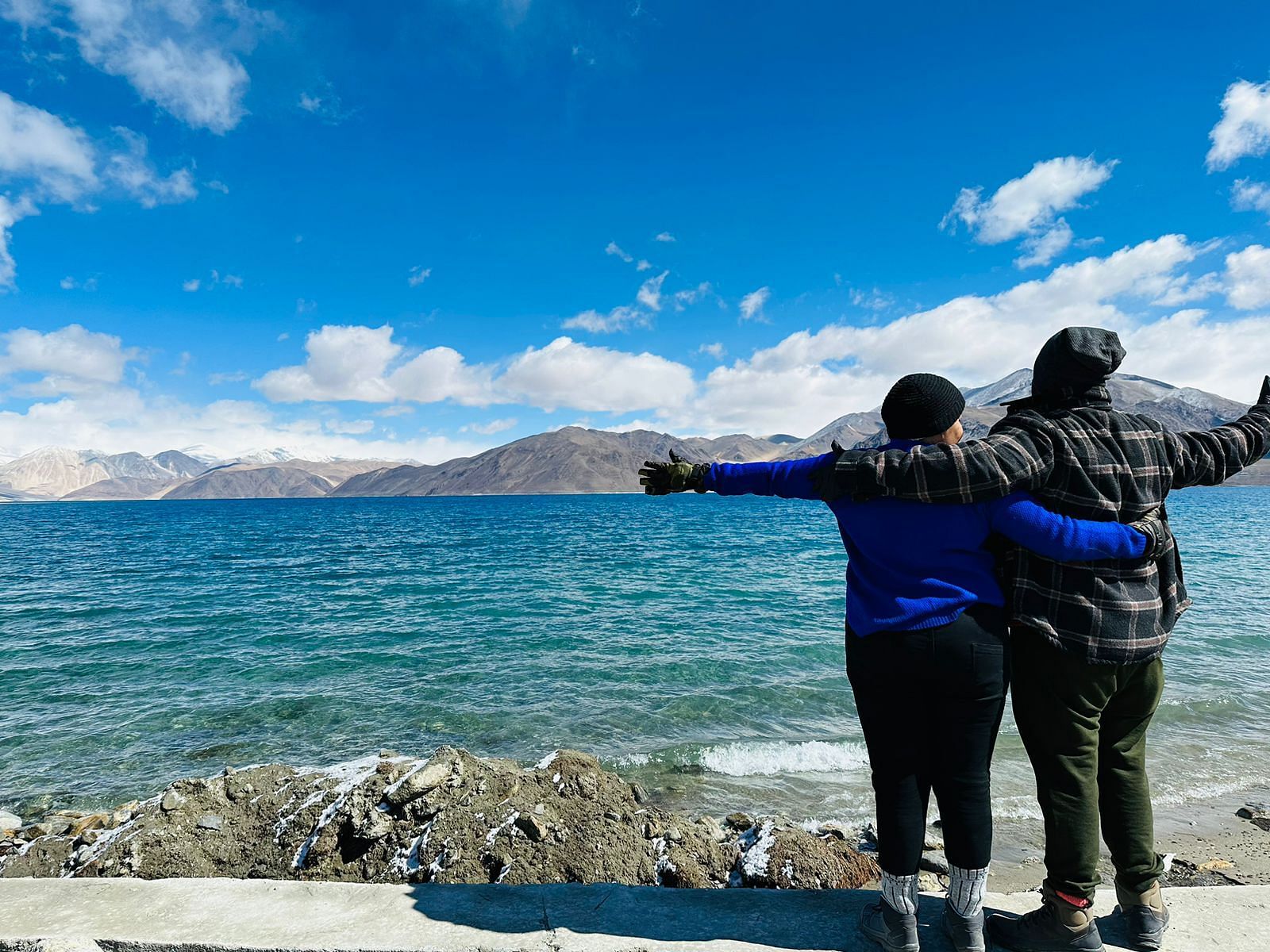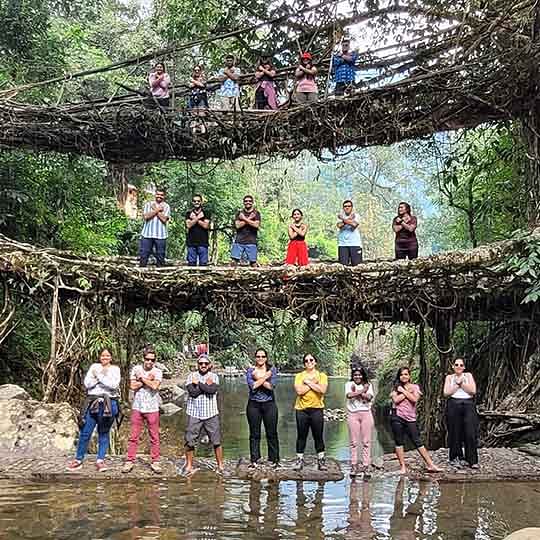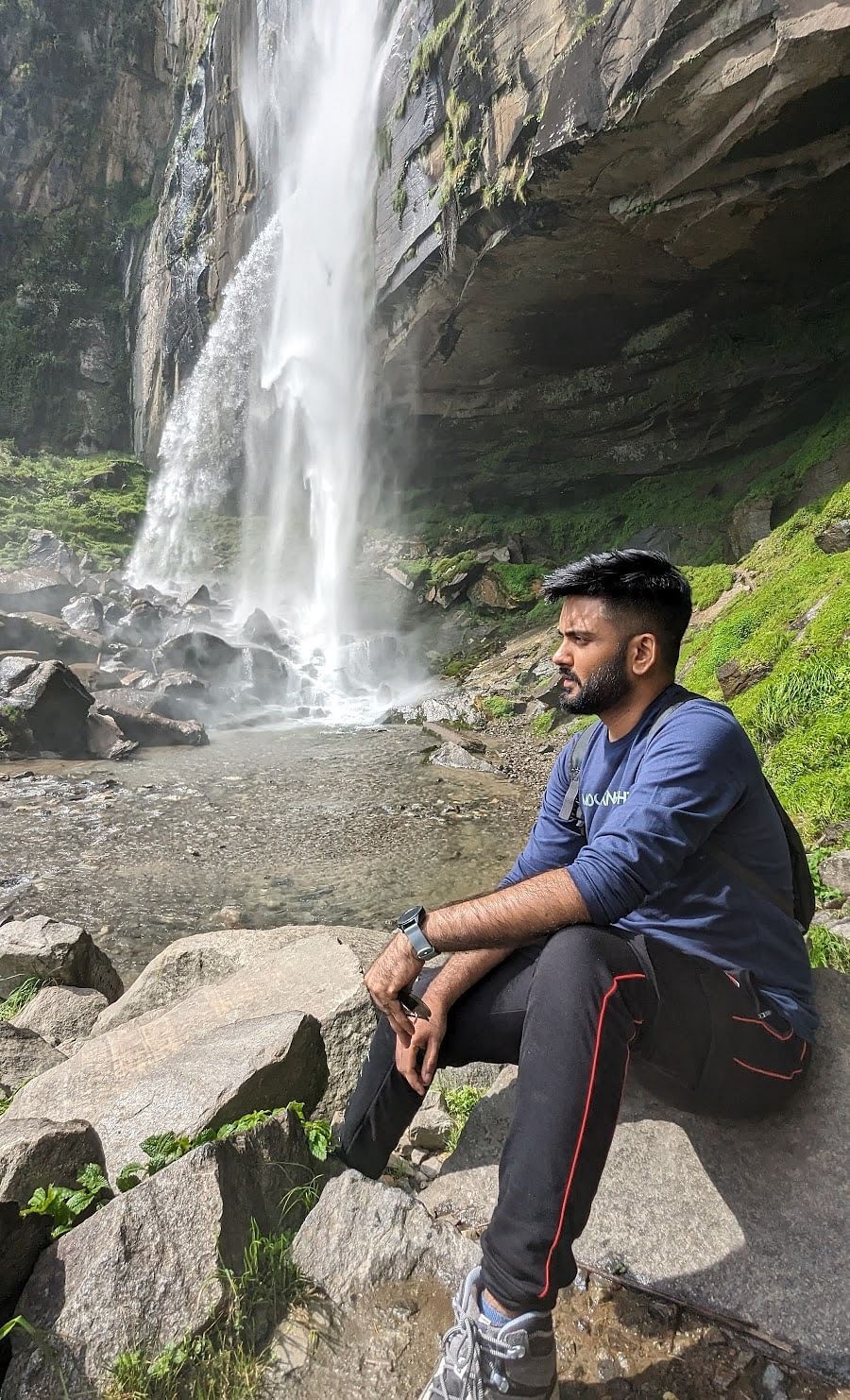Looking for things to do in Kyoto? Ryoan-ji Temple should be at the top of your list. This 600-year-old temple is home to Japan’s most famous rock garden, where 15 stones sit mysteriously on a bed of white gravel. Some stones stay hidden, no matter where you stand – a puzzle that has amazed visitors for centuries.Beyond the famous garden, the temple grounds offer peaceful walking paths around a large pond, where you can spot turtles sunbathing on rocks and maple trees turning brilliant colors in fall. Many visitors say it’s less crowded than other places to visit in Kyoto, making it perfect for quiet reflection or photography.
Getting to Ryoan-ji Temple is easy with our Japan Tour Packages that cover Kyoto’s main attractions. Come early in the morning to beat the crowds and give yourself time to sit on the wooden viewing platform, taking in one of Japan’s most thoughtful spaces.
A Short History of Ryoan-ji Temple
Ryoan-ji Temple, also called the “Temple of the Dragon at Peace,” was built in 1450 during Japan’s Muromachi period. Originally, it was a large estate for a noble family, but it was later converted into a Zen Buddhist temple. Over the centuries, the temple faced numerous challenges, including wars and natural disasters, but it was always restored with great care. Today, Ryoanji stands as a symbol of Japan’s cultural and spiritual heritage. It is part of the historic monuments of ancient Kyoto and is recognized as a UNESCO World Heritage Site. Exploring Ryoan-ji temple is one of the best things to do in Japan.
Suggested Read: Akihabara Electric Town
How to Reach Ryoan-ji Temple
Ryoan-ji Temple is a famous Zen temple in Kyoto, known for its beautiful rock garden. If you’re planning to visit, here’s how you can get there:From Kyoto Station:
By Bus: At Kyoto Station, go to bus platform JR3 and take the JR bus bound for “Ryoanji-mae.” The ride takes about 30 minutes and costs 230 yen. This bus is covered by the Japan Rail Pass and other JR passes. Buses run every 15-30 minutes.
By Train: Alternatively, from Kyoto Station, you can take the Karasuma Subway Line to Kitaoji Station. From there, transfer to a bus bound for “Ritsumeikan Daigaku-mae.” After getting off, it’s about a 7-minute walk to the temple.
From Kinkaku-ji (Golden Pavilion):
By Bus: Ryoan-ji Temple is about a 5-minute bus ride west of Kinkaku-ji. You can take a local bus from Kinkaku-ji to “Ryoanji-mae.” Alternatively, it’s a pleasant 20-minute walk between the two temples.
By Keifuku Railway (Randen):
From Central Kyoto: Take the Keifuku Kitano Line to the “Ryoanji-michi” Station. From there, it’s a 5-10 minute walk to the temple. This charming local train runs through quiet residential areas, offering a scenic route to the temple.
By Taxi: Taxis are readily available throughout Kyoto. A taxi ride from Kyoto Station to Ryoan-ji Temple takes about 20-30 minutes, depending on traffic, and costs approximately 1500 INR to 2000 INR.
Tips:
Kyoto Bus Pass: If you plan to use buses frequently, consider purchasing a Kyoto City Bus One-Day Pass for 350 INR, which offers unlimited rides on city buses for a day.
Timing: Buses and trains can be crowded during peak tourist seasons, so plan your trip accordingly.
Walking: Kyoto is a pedestrian-friendly city. If the weather is nice, walking between attractions like Kinkaku-ji and Ryoan-ji can be a pleasant experience. You might also like to go shopping in Kyoto after your day at this temple.
The Ryoanji Temple Rock Garden Kyoto
The Ryoanji Temple Rock Garden Kyoto is the temple’s most iconic feature. Considered a masterpiece of Zen Garden Kyoto design, it represents the essence of simplicity and harmony. 1. A Minimalist Wonder
This rock garden Kyoto is not particularly large, yet it has a profound impact on visitors. It is a rectangular plot filled with carefully raked white gravel and 15 meticulously placed rocks. The arrangement is such that, from any angle, only 14 rocks are visible at one time. According to legend, only someone who has achieved spiritual enlightenment can see all 15 stones simultaneously.
The garden’s meaning is intentionally left ambiguous, allowing visitors to interpret it in their own way. Some view the rocks as islands floating in a sea, while others see mountains or constellations. Regardless of interpretation, the garden’s simplicity invites quiet reflection and contemplation.
2. The Art of Raking
One fascinating aspect of the Ryoanji Temple Rock Garden Kyoto is the daily maintenance. The white gravel is raked into precise patterns, symbolizing waves or ripples. The raking process is an act of meditation for the temple monks, emphasizing the importance of mindfulness in Zen philosophy.
3. Exploring the Temple Grounds
Beyond the Ryoanji Temple Rock Garden, the temple grounds offer a variety of scenic and peaceful attractions that make it one of the must-visit Kyoto tourist attractions. You must also visit Nanzen-Ji Temple located nearby.
4. Kyoyochi Pond
Kyoyochi Pond, created in the 12th century, is a beautiful feature of Ryoan-ji Temple. Surrounded by greenery, cherry blossoms in spring, and vibrant autumn leaves, the pond is a perfect spot for a relaxing stroll. The reflections on the water create a peaceful and beautiful scene that changes with the seasons.
5. The Main Hall (Hojo)
The Hojo, or main hall, of Ryoanji, is a simple wooden structure that complements the Zen philosophy of minimalism. Inside, visitors can see traditional Japanese paintings and sliding doors that overlook the rock garden Kyoto. The view from the Hojo enhances the meditative experience of the garden.
6. Walking Paths
The temple grounds are filled with peaceful walking paths that take visitors through forests, past small shrines, and along the edges of the pond. These paths provide a chance to enjoy the natural beauty of Kyoto while connecting with the spiritual ambiance of the temple.
Suggested Read: Universal Studio Japan
The Appeal of Ryoan-ji Temple
Ryoan-ji Temple is one of the most significant Kyoto tourist attractions, drawing visitors from all over the world. Its unique combination of history, art, and spirituality offers something for everyone.
The temple’s Zen Garden Kyoto is particularly popular with those looking for calmness and inspiration. Sitting quietly by the Ryoanji Temple Rock Garden, many visitors find themselves feeling calmer and more focused. The simplicity of the garden’s design has a universal appeal, making it a memorable experience for all who visit.
Ryoanji Temple Opening Hours
Planning your visit is essential to fully enjoy the experience of Ryoan-ji Temple. The Ryoanji Temple opening hours are as follows: March to November: 8:00 AM to 5:00 PM
December to February: 8:30 AM to 4:30 PM
Arriving early in the morning or later in the afternoon is recommended for those who wish to enjoy the peaceful atmosphere without large crowds.
Tips for Visiting Ryoan-ji Temple
To make the most of your visit to Ryoan-ji Temple, keep the following tips in mind: 1. Visit During Off-Peak Hours: Early mornings and late afternoons are the best times to avoid the crowds.
2. Wear Comfortable Shoes: The temple grounds are extensive, and you’ll likely spend a lot of time walking.
3. Take Your Time: Don’t rush through the Ryoanji Temple Rock Garden or the walking paths. The beauty of the temple lies in its ability to encourage relaxation and reflection.
4. Read About Zen Philosophy: Learning a bit about Zen Buddhism can deepen your understanding of the garden and the temple’s significance.
5. Bring a Camera or Notebook: Capture the beauty of the temple or jot down your thoughts and feelings during your visit.
Suggested Read: Mount Fuji, Japan
Seasonal Beauty at Ryoan-ji Temple
Every season brings a unique charm to Ryoan-ji Temple, making it a destination worth visiting at any time of the year. - Spring: Cherry blossoms bloom around Kyoyochi Pond and along the temple paths, creating a magical atmosphere.
- Summer: The temple grounds are lush and green, with the sound of cicadas adding to the peaceful ambiance.
- Autumn: Vibrant red, orange, and yellow leaves transform the temple into a colorful wonderland.
- Winter: Snow blankets the Ryoanji Temple Rock Garden, giving it a quiet and pure beauty that enhances its meditative qualities.
Nearby Kyoto Tourist Attractions
When you visit Ryoan-ji Temple, you’ll find that there are many other wonderful places to explore nearby. Kyoto is filled with beautiful spots, making it one of the most popular cities for travelers. Here are some must-visit Kyoto tourist attractions close to Ryoan-ji Temple. 1. Kinkaku-ji (The Golden Pavilion)
Just a short walk or bus ride from Ryoan-ji Temple, you’ll find Kinkaku-ji, also called the Golden Pavilion. It’s one of the most famous places in Japan. The temple is covered with gold leaf, which makes it shine beautifully in the sunlight.
The Golden Pavilion sits next to a calm pond, and you can see its reflection in the water. The garden around the temple is lovely and peaceful, perfect for a relaxing stroll. If you visit in winter, the sight of snow on the golden building is especially magical.
2. Ninna-ji Temple
Only about 10 minutes from Ryoanji Temple, Ninna-ji Temple is another important place to visit. It’s a UNESCO World Heritage Site with a long history, dating back to 888 AD.
This temple is famous for its five-story pagoda and its cherry blossom trees called Omuro Sakura, which bloom a little later than other cherry trees in Kyoto. The temple grounds are large, with quiet gardens and wooden halls that show the beauty of traditional Japanese architecture.
3. Myoshin-ji Temple Complex
Not far from Ryoan-ji Temple, you can visit the Myoshin-ji Temple Complex, the largest Zen temple complex in Kyoto. It has over 50 small temples, offering a deep dive into Zen Buddhism.
The main temple is very impressive, and some of the sub-temples have rock gardens similar to the Ryoanji Temple Rock Garden. Walking around this quiet area is a calming experience and gives you a chance to see another side of Kyoto’s culture. You must explore Nijo Castle situated within walking distance.
Suggested Read: Nishiki Market, Kyoto
4. Arashiyama Bamboo Grove
If you’re willing to travel a little further, the Arashiyama Bamboo Grove is one of the most magical Kyoto tourist attractions. This bamboo forest feels like a fairytale, with tall green stalks swaying gently in the wind.
You can also explore other spots in Arashiyama, like the Togetsukyo Bridge or Monkey Park Iwatayama. These places give you a mix of nature, wildlife, and beautiful scenery, making it a great day trip from Ryoanji Temple.
5. Daitoku-ji Temple Complex
A little to the northeast of Ryoan-ji Temple, the Daitoku-ji Temple Complex is a great place to see more Zen gardens and temples. This area is quieter than some of the bigger attractions, making it a peaceful spot to visit.
One of the temples here, Ryogen-in, has one of the oldest rock gardens in Japan. It’s a smaller and more personal experience compared to the Ryoanji Temple Rock Garden, but just as inspiring.
6. Kitano Tenmangu Shrine
Close to Ryoan-ji Temple, the Kitano Tenmangu Shrine is another special place to visit. This shrine is dedicated to the deity of learning and is popular with students who come to pray for success in their studies.
The shrine is beautiful all year round, but it’s especially famous for its plum blossoms in February and March. If you’re in Kyoto on the 25th of any month, you can also visit the shrine’s flea market, where you can buy antiques, crafts, and tasty local snacks.
7. Philosopher’s Path
If you enjoy peaceful walks, the Philosopher’s Path is a beautiful spot to visit. Although it’s a bit further from Ryoanji, this path runs along a canal lined with cherry trees. It’s especially lovely during spring when the blossoms are in full bloom.
The path also connects to other famous temples, like Ginkaku-ji (the Silver Pavilion), making it a perfect addition to your Kyoto trip.
8. Kiyomizu-dera Temple
Though not very close, Kiyomizu-dera Temple is one of Kyoto’s most famous landmarks and is worth visiting. Its large wooden stage offers amazing views of the city, especially during cherry blossom season or autumn when the leaves turn red.
The streets leading to the temple are lined with traditional shops selling souvenirs, snacks, and sweets. It’s a lively and colorful place that contrasts beautifully with the peaceful atmosphere of Ryoan-ji Temple.
9. Toei Kyoto Studio Park
For something different, visit Toei Kyoto Studio Park, located about 15 minutes from Ryoan-ji Temple. This theme park lets you experience what life was like during Japan’s Edo period.
You can walk through streets with old-style buildings, watch samurai performances, and even try on traditional costumes. It’s a fun experience for families or anyone interested in Japanese history.
Suggested Read: Shinjuku Gyoen National Garden
What Makes Ryoan-ji Temple Unique?
Ryoanji Temple stands out among Kyoto’s many attractions because of its profound simplicity. While other temples may dazzle with intricate decorations and bold colors, Ryoan-ji Temple emphasizes balance, calmness, and reflection. Do visit Fushimi Inari Tiasha located Nearby.The Ryoanji Temple Rock Garden is a prime example of this philosophy. Its minimalist design leaves room for personal interpretation, encouraging visitors to find their own meaning and peace within its quiet beauty.
A visit to Ryoan-ji Temple is a journey into the heart of Japanese culture, history, and spirituality. The Ryoanji Temple Rock Garden, with its mysterious and elegant simplicity, is a highlight that has inspired countless visitors. From the peaceful Kyoyochi Pond to the peaceful walking paths, every part of Ryoan-ji Temple offers an opportunity to connect with nature and yourself. As one of the top Kyoto tourist attractions, it provides a unique and memorable experience that stays with you long after your visit.
Before heading to this iconic site, remember to check the Ryoanji Temple opening hours and plan your visit to make the most of your time.
Whether you’re drawn by its history, its beauty, or its spiritual significance, Ryoan-ji Temple is sure to leave you feeling inspired and at peace.




